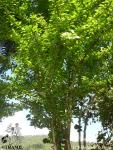1 GERMOSEN-ROBINEAU L, GERONIMO M, AMPARO C, 1984 Encuesta TRAMIL. enda-caribe, Santo Domingo, Rep. Dominicana.
2 WHO, 1991 Guidelines for the assessment of herbal medicines. WHO/TRM/91.4. Programme on Traditional Medicines, WHO, Geneva, Switzerland.
3 JOSEPH H, BOURGEOIS P, 1989 Contribution à la connaissance de Crescentia cujete L. Rapport TRAMIL. Laboratoire de phytochimie, Université des Antilles et de la Guyane, Pointe à Pitre, Guadeloupe.
4 ZWAVING J, 1986 Selección fitoquímica preliminar en algunas plantas TRAMIL. Laboratorio de Farmacognosia, Universidad de Groningen, Groningen, Holanda.
5 AGARWAL K, POPLI SP, 1992 The constituents of Crescentia cujete leaves. Fitoterapia 63(5):476.
6 GRIFFITHS LA, 1959 On the distribution of gentisic acid in green plants. J Exp Biol 10:437.
7 BLOHM H, 1962 Poisonous plants of Venezuela. Cambridge, USA: Harvard University Press, p136.
8 BADAMI R, SHANBHAG M, 1975 Minor seed oils. VIII: Examination of seed oils rich in unsaturated acids. J Oil Technol Assoc India 7(3):78-79.
9 CHEN C, 1983 Napthoquinone constituents of Crescentia cujete wood. Oa Hsueh 41(1):9-12.
10 LE GRAND A, WONDERGEM PA, 1986 Antimicrobial activity of 10 Caribbean species. TRAMIL inform. Dep. of Pharmacognosy, University of Leyden, Leyden, Holland.
11 GUPTA M, ESPOSITO AVELLA M, 1988 Evaluación química y farmacológica de algunas plantas medicinales de TRAMIL. CIFLORPAN, Universidad de Panamá, Panamá, Panamá.
12 VERPOORTE R, DIHAL PP, 1987 Medicinal plants of Surinam. IV. Antimicrobial activity of some medicinal plants. J Ethnopharmacol 21(3):315-318.
13 CACERES A, SAMAYOA B, 1989 Tamizaje de la actividad antibacteriana de plantas usadas en Guatemala para el tratamiento de afecciones gastrointestinales. Guatemala, Guatemala: Dirección General de Investigaciones, Universidad San Carlos (DIGI-USAC).
14 CONTRERAS A, ZOLLA C, 1982 Plantas tóxicas de México. Instituto Mexicano del Seguro Social, México DF, México.
15 CACERES A, 1992 Plants used in Guatemala for the treatment of respiratory diseases. 2: Evaluation of activity of 16 plants against Gram positive bacteria. Facultad de Ciencias Químicas y Farmacia, Universidad de San Carlos, Guatemala, Guatemala.
16 STANDLEY PC, 1938 Flora de Costa Rica, Pt. IV. Chicago,USA: Field Museum of Nat History p783.
17 HETZEL CE, GUNATILAKA AA, GLASS TE, KINGSTON DG, HOFFMANN G, JOHNSON RK, 1993 Bioactive furanonaphthoquinones from Crescentia cujete. J Nat Prod 56(9):1500-1505.




















